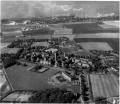Darenth Park Hospital
| Darenth Park Hospital | |
|---|---|
 | |
| Established | 1873 |
| Opened | 1878 |
| Closed | 1988 |
| Demolished | 1995 |
| Current Status | Demolished |
| Building Style | Pavilion Plan |
| Location | Dartford, Kent |
| Alternate Names |
|
History[edit]
Darenth Asylum for 'imbeciles and school for imbecile children', was erected in 1878 by the managers of the Metropolitan Asylum district (Metropolitan Asylums Board), and constituted one of the largest establishments of its kind. The buildings, at a cost of ten thousand pounds, and were designed by the architects Messrs C and A Harston, of London in the Gothic style. A new wing was added in 1888 at a cost of fifty thousand pounds, to hold 400 'imbecile' children, and a smallpox convalescent hospital was built in Darenth wood, at a cost of sixty-three thousand pounds, for a further 600 patients. The school was used to house nearly 1,000 'imbecile' children and the asylum accommodated 1,500 adults. The grounds and farm comprise about 170 acres, including a small part of Darenth wood. The asylum had its own gas works and the water supply was derived from a well 250 foot deep, the water was then pumped to the two tower tanks at the rate of about 100,000 gallons per day; sewage was disposed of by irrigation on the farm land. One acre of the ground was set apart and consecrated as a cemetery.
The Asylum was one of the first to attempt to train and develop mentally disabled children, by offering schooling and industrial training. So that this training should not have to be stopped at age 16, and trained children return to general asylums where their skills would not be used, the Darenth Adult Asylum was constructed on land adjacent to the school and opened in 1880.
In 1921, when it had 1668 beds, it was renamed the Darenth Training Colony. By 1924 bed numbers had increased to 2260. The Colony was wired for electricity in 1926, at a cost of £9,300, and a new automatic telephone system installed at a cost of £1615. In 1927 a War Memorial for the Colony was unveiled (the Memorial is now at the entrance to the cemetery).
By 1930 the Colony was producing goods to the value of £70,000 a year. The female patients did laundry and domestic work, and produced items for sale - 'flat needlework' (towels, sheets, pillowcases, etc), rugs and knitted garments and socks. Male patients undertook brick-laying, carpentry, decorating, plumbing, helping to maintain the buildings. They made shoes, mattresses, mats, brushes, baskets and toys, and also did tailoring, printing and book-binding. Tinsmiths made kettles, coal-scuttles and other household items, while carpenters made benches and stools. They also did baking and domestic work. Some worked as gardeners or on the farm.
In 1948 it joined the NHS. It had 2260 beds. A special ward was opened in 1949 for maladjusted patients whose behavior was undisciplined and irresponsible. By 1954 the number of beds was 2058. In 1959 children were once again admitted to the Hospital. A school was opened so these severely mentally handicapped children could be helped to improve their speech and mobility, as well as their social skills. In 1967 a new wing was built for boys aged between 11 and 16 years, and another one was planned for girls.
By the 1970s the Hospital was in a poor state of repair and needed re-wiring. It had over 40 wards, ten of which housed more than 50 patients each, and there was only one lift in the entire complex. Its catchment area of South East London, Kent and parts of Sussex meant that relatives had long and difficult journeys to reach the isolated site. In 1973 the Regional Hospital Board decided that conditions were unacceptable by modern standards and that the Hospital should close. The school closed in 1978 and the children transferred to the new Milestone School.
The closure programme was implemented slowly to allow institutionalized patients time to adjust (40% had lived at the Hospital for more than 25 years). Patients had to learn how to cook for themselves, how to shop and how to use a door key. They were gradually transferred to other hospitals, hostels, homes and other facilities throughout South East England. Orchard House at Joyce Green Hospital and Archery House at Stone House Hospital accommodated some of the severely mentally handicapped patients.
By 1984 the Hospital had 735 beds and, by the following year, 695. The Darenth Park Hospital finally closed in 1988 - the first NHS institution of its kind to close as a result of government policy to move mental health care out of hospitals and into 'the community'.



